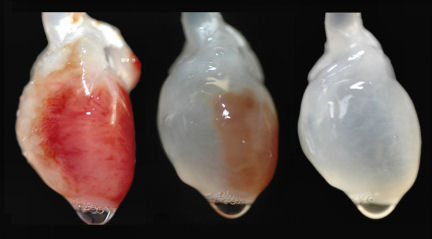Heart revival
Scientists have found a way to transform a rat's dead heart into a living one.
By Emily Sohn
When your heart works like it’s supposed to, it keeps you alive and well. But when the heart fails, people can get very sick or even die.
Now, scientists have found a way to turn dead rat hearts into living ones. It’s a medical first, and the technique may eventually allow doctors to make new hearts from patients’ own cells. This should largely avoid the risk that the patient’s body will reject the new heart, which often happens today.
 |
|
By running a liquid detergent through a rat’s heart (left), researchers gradually washed out its cells (center). What remained was a shell of the heart, made up of proteins (right). |
| Thomas S. Matthiesen, Univ. of Minnesota |
Researchers from the University of Minnesota in Minneapolis started with hearts from rats that had been dead for less than 18 hours. Led by Doris A. Taylor, the scientists put the hearts in glass beakers and used a liquid detergent to wash away the dead cells.
Left behind was a heart-shaped mass of proteins that normally surround heart cells and hold them together. The mass was translucent, which means it lets light through, and it had the consistency of Jell-O.
Next, Taylor and her colleagues took cells from hearts of newborn rats. They injected these living cells into the hollowed-out hearts.
Eight days later, the hearts were pumping weakly. And the injected cells in each heart beat synchronously—that is, all at the same time.
“The fact that we can get these cells to beat synchronously is incredibly encouraging,” Taylor says. It will be years before doctors might consider using this method to repair hearts in people, the scientists warn. In the study, the rebuilt hearts could pump blood only about 2 percent as fast as a normal adult rat heart can.
Eventually, scientists would like to be able to use primitive stem cells (see “From Stem Cell to Any Cell”) from a patient’s blood or heart tissue to repair his or her own organs.
Going Deeper:
Barry, Patrick. 2008. Phoenix heart: Replacing a heart’s cells could ease transplants. Science News 173(Jan. 19):35-36. Available at http://www.sciencenews.org/articles/20080119/fob2.asp .
Sohn, Emily. 2005. From stem cell to any cell. Science News for Kids (Oct. 19). Available at http://www.sciencenewsforkids.org/articles/20051019/Feature1.asp .







